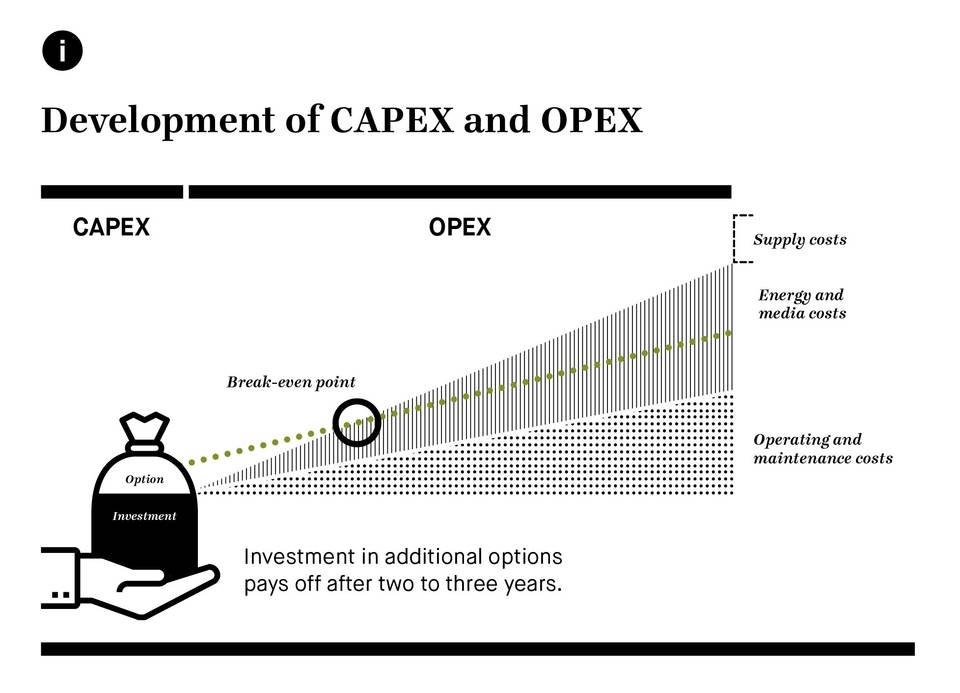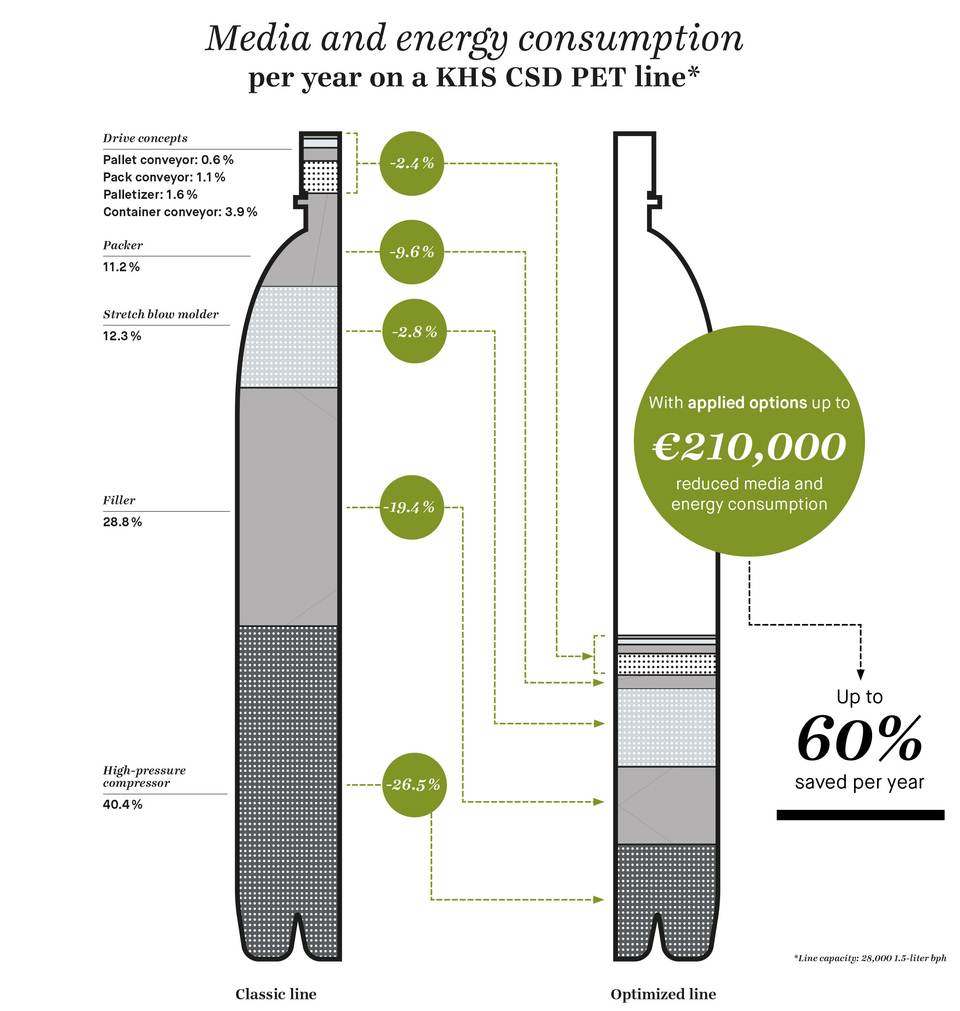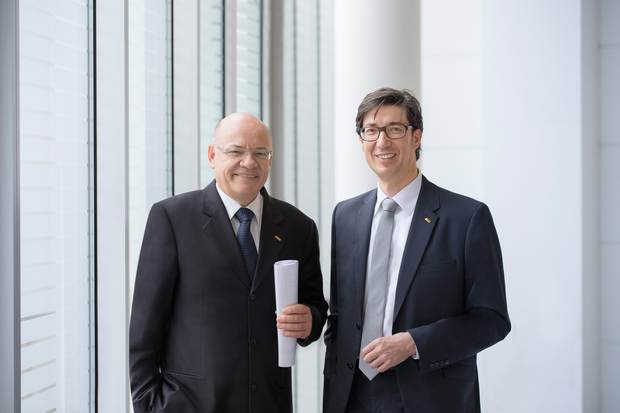KHS’ top theme at BrauBeviale and in the last issue of KHS competence was the total cost of ownership or TCO. This examines both capital expenses (CAPEX) for the cost of investment when procuring a line and the operating expenses (OPEX) throughout the entire life cycle of the machines in order to safeguard economically prudent and sustainable decisions regarding the technical equipment at a production plant. Above all else, operating expenses include costs for energy and media consumption and packaging materials. They also cover expenses for personnel and for the maintenance and servicing of technical systems. In view of the long service life of a filling system (which usually runs for fifteen years or more) it’s no surprise to learn that on PET lines the OPEX share of the overall cost is between 92% and 97% per filled container while the share of the investment cost is only about 3% to 8%. Taking production on a PET filling system for CSDs by way of example, the following illustrates just how large the potential savings for OPEX can be where innovative KHS technology options are installed.
Planning is crucial
“The combination of nominal savings with high line availability is what provides our customers with a sound overall concept,” says Mario Beck, head of Sustainability/TCO at KHS. “We thus have to design the layout of the line accordingly – using suitable machine combinations – during the planning stage. This extends into the drafting or selection of a maintenance contract which itself can make a difference when it comes to upholding the performance and efficiency of PET lines.” In the twin block concept for PET lines, for example, the first block contains the stretch blow molder and filler and the conveyor technology for decoupling and buffering. The labeler, packer with a shrink tunnel and palletizer constitute the second block. Compared to the classic PET line this concept does not need a buffer between the labeler and packer. In conjunction with a forward-looking, counting control, the result is a sustainable line concept.


Less energy, more sustainability
In the first block the focus is on saving energy and resources. This starts with the stretch blow molder, one example being the heating process in the InnoPET Blomax 12 S. The heat input for preform heating consists of near infrared (NIR) – shortwave infrared radiation with an especially high energy density – which consumes up to 30% less energy versus the IR technology common to the market. There is less material loss during the startup phase; in addition, the heater has been shortened by 20%.
Up to 75% of energy is saved on the high-pressure compressor, the largest contribution being made by AirbackPlus, an innovative blow air recycling system where the compressed air is not vented to the atmosphere but fed back into the process circuit through a special Airback ring line. This consumes up to 40% less blow air. Technical improvements, such as improved processing and cooling time, internal bottle cooling and reduced preform contact time, boost the output to up to 2,500 bottles per hour and blow mold. This allows energy costs to be cut by approximately €36,000 annually, investment expenses by about 20% – thanks to smaller machine sizes – and the floor space required by around 15%.
Economical and ecological profit is promised by the Bottles & Shapes™ program which reduces the amount of PET used and thus generates material savings of up to 30%. Lighter bottles also need less heating and blowing energy during the stretch blow molding process and can be packaged in thinner film. In addition, CO₂ emissions can be decreased in the filler area from the usual approximately 600 grams per hectoliter to around 150 grams per hectoliter with the help of progressive Eco Space valves. By reworking all parts exposed to the product, the times for format changeovers have also been reduced and maintenance time cut by 20%. This is equivalent to a production of 5.6 million containers per year.
Streamlined packaging
The accent in the packaging and palletizing area is also on saving energy and materials. The patented FullyEnclosed FilmPack on the Innopack Kisters packaging machine is a type of film packaging which groups individual containers into stable packs without the need for any cardboard. This saves about 50% in packaging material compared to packs formed with pads or trays and film and up to 42% in costs for materials. As the image printed on the film is less heavily distorted, the resulting visual quality of the packaging is high, and a handle can be applied. Further options include film web control, for instance, which can save about 10% in film, and film spreading on diverter elements made of a microporous material; the latter variant requires around 90% less compressed air than the standard process which involves the use of a perforated steel cylinder. Top energy-saving options include the optimized shrink tunnel chain cooler, whose saving of approximately 10% has been certified by TÜV SÜD, and stand-by mode for the shrink tunnel, where all of the functions not needed during a production phase are shut down and the tunnel automatically closed by shutters – a minor modification with a great effect.
Intelligent control
“One real highlight is what’s known as the counting control,” says Beck happily. This tracks the product flow on the line, including the machine states, by counting the containers. Unlike conventional control units which use sensor technology this process precisely identifies the situation on the individual machine segments and records or takes into account the actual quantities of labels and packaging film. The individual machine states are detected earlier than they used to be by an intelligent interface to the machines and regulated with foresight. If a change of label or film reel is predicted, for example, the area upstream of this runs empty in good time, giving the stretch blow molder/filler block enough buffer capacity to enable production to continue while the reel is being changed. “All told, this allows us to control the line more gently and extremely dynamically. This results in less wear and the energy consumption drops,” Beck summarizes.
Safeguarding performance in the long term
Looking at the material consumption alone, the biggest cost factor in beverage bottling, just shows how great the economic potential of all of these measures is. If, on a line with a capacity of 28,000 1.5-liter bottles per hour, the bottle weight is reduced by 8 grams, the annual material costs of €9.1 million can be decreased by 23% to €7 million – an impressive figure that Beck has calculated.
How efficient and powerful the machines prove to be throughout their entire life cycle ultimately depends on the care the customer takes of them. To this end KHS has put together a number of service packages which cater to every requirement. These packages range from the Start-up package at system handover through the Basic and Advanced packages to the Comfort package which even includes an embedded engineer: a specialist assigned by KHS specifically for maintenance of the customer’s line. With these carefully thought-out service packages KHS not only covers planning and implementation but has also developed a full concept which ensures line availability and a reduction in operating costs.
KHS’ customers also think so and at BrauBeviale they showed great interest in the multitude of measures and options which help to reduce the TCO of their plant technology. “With this we can give our customers really effective support,” says Beck, not without a modicum of pride – and not thinking first and foremost of the technical innovations and details. “With our expert advice and range of consultancy services we’re proving to be real pioneers. But at the end of the day, what’s really important is that the customer is satisfied.”
Your contact on this topic
Mario Beck
Head of Sustainability/TCO/
KHS GmbH, Bad Kreuznach, Germany
Phone: +49 671 852-2880
Email: mario.beck@khs.com






















